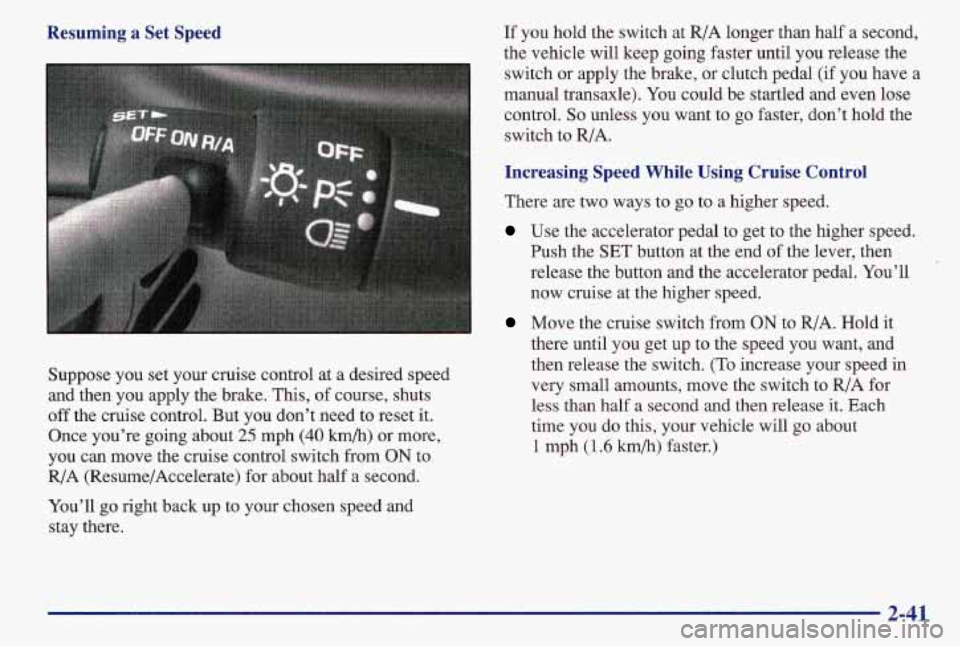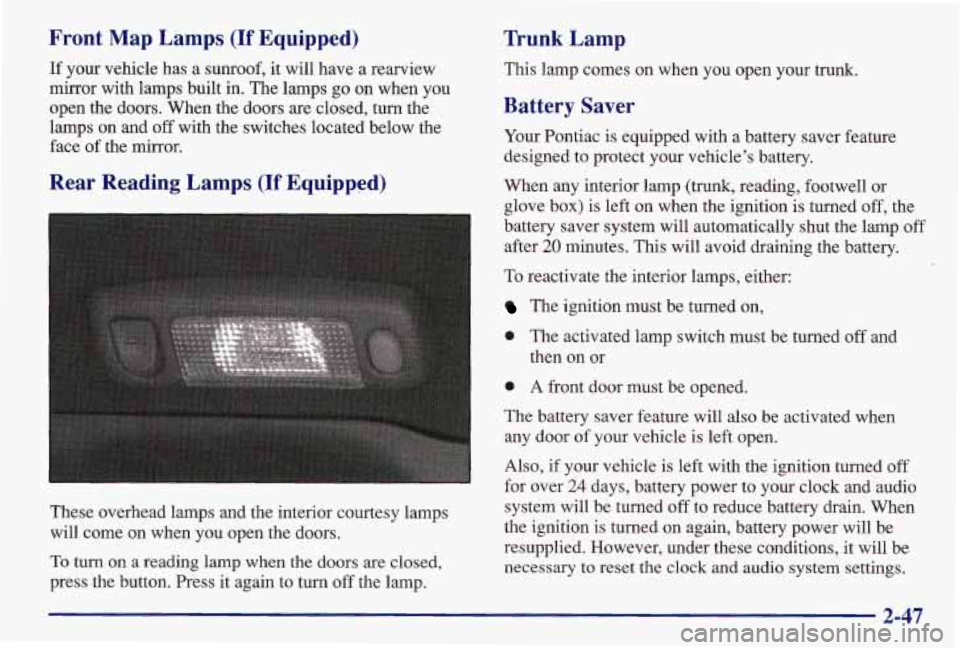Page 95 of 371
Setting Cruise Control
A CAUTION:
If you leave your cruise control switch on when
you’re not using cruise,
you might hit a button
and go into cruise when
you don’t want to. You
could be startled and even lose control. Keep the
cruise control switch
OFF until you want to
use it.
1. Move the cruise control switch to ON.
2. Get up to the speed you want. 3. Push in the SET button at the end of the lever and
release
it.
4. Take your foot off the accelerator pedal.
2-40
Page 96 of 371

Resuming a Set Speed
Suppose you set your cruise control at a desired speed
and then you apply the brake. This, of course, shuts
off the cruise control. But you don’t need to reset it.
Once you’re going about
25 mph (40 h/h) or more,
you can move the cruise control switch from
ON to
R/A (Resume/Accelerate) for about half a second.
You’ll go right back up to your chosen speed and stay there. If you
hold the switch at R/A longer than half a second,
the vehicle will keep going faster until you release the
switch or apply the brake, or clutch pedal (if you have a
manual transaxle).
You could be startled and even lose
control,
So unless you want to go faster, don’t hold the
switch to R/A.
Increasing Speed While Using Cruise Control
There are two ways to go to a higher speed.
Use the accelerator pedal to get to the higher speed. Push the
SET button at the end of the lever, then
release the button and the accelerator pedal. You’ll now cruise at the higher speed.
Move the cruise switch from ON to R/A. Hold it
there until you get up to the speed you want, and
then release the switch.
(To increase your speed in
very small amounts, move the switch to R/A for
less than half a second and then release it. Each
time you do this, your vehicle will go about
1 mph (1.6 km/h) faster.)
2-41
Page 97 of 371

Reducing Speed While Using Cruise Control
There are two ways to reduce your speed while using
cruise control:
Press in the button at the end of the lever until you
reach the lower speed you want, then release it.
To slow down in very small amounts, push the
button for less than half a second. Each time
you do
this, you’ll go
1 mph (1.6 km/h) slower.
Passing Another Vehicle While Using Cruise Control
Use the accelerator pedal to increase your speed. When
you take your foot off the pedal, your vehicle will slow
down to the cruise control speed you set earlier.
Using Cruise Control on Hills
How well your cruise control will work on hills depends
upon your speed, load, and the steepness
of the hills.
When going up steep hills, you may have to step on the accelerator pedal to maintain your speed. When going
downhill, you may have to brake or shift to a lower gear
to keep your speed down. Of course, applying the brake
takes you out
of cruise control. Many drivers find this to
be too much trouble and don’t use cruise control on
steep hills.
Ending Cruise Control
There are two ways to turn off the cruise control:
Step lightly on the brake pedal or push the clutch
pedal,
if you have a manual transaxle: OR
Move the cruise switch to OFF.
Erasing Cruise Speed Memory
When you turn off the cruise control or the ignition,
your cruise control set speed memory
is erased.
2-42
Page 98 of 371
Exterior Lamps
Headlamps
I-
Rotate the turn signal lever middle ring up one position
to turn on:
Parking Lamps
Sidemarker Lamps
0 Taillamps
0 License Plate Lamps
0 Instrument Panel Lights Rotate the turn signal lever middle ring up two positions
to
turn on:
Headlamps
0 Parking Lamps
Sidemarker Lamps
Taillamps
License Plate Lamps
Instrument Panel Lights
Rotate the switch to
OFF to turn all of the lamps off.
Lamps On Reminder
If you open the driver’s door and turn off the
ignition while leaving the lamps
on, you will hear a
warning chime.
2-43
Page 99 of 371

Daytime Running Lamps
Daytime Running Lamps (DRL) can make it easier for
others to see the front
of your vehicle during the day.
DRL can be helpful in many different driving
conditions, but they can be especially helpful in the
short periods after dawn and before sunset.
The DRL system will make your high-beam headlamps
come on at a reduced brightness when:
The engine is running,
0 The headlamp switch is in the OFF position,
The light sensor detects daytime light,
0 The parking brake is released and
The shift lever is not in PARK (P) on an
automatic transaxle.
When the DRL system is on, the taillamps, sidemarker,
park lamps
and instrument panel lights will not be
illuminated.
The DRL and the ALC systems will remain off any time
your automatic transaxle vehicle is in PARK (P) and the
parking brake is engaged.
The DRL and the ALC systems will remain
off any time
your manual transaxle vehicle is in NEUTRAL (N) and
the parking brake is engaged.
Automatic Light Control (ALC)
Your vehicle is equipped with an automatic light sensor
on top of the instrument panel under the defroster grill,
so be sure it is not covered which will cause the
nighttime lights to be on continuously.
When it is dark enough outside, your ALC will turn
on
your low-beam headlamps at the normal brightness
along with other lamps such as the taillamps,
sidemarker, park lamps and instrument panel lights.
There is a 20-second delay in the transition between
daytime and nighttime operation
of the DRL and the
ALC systems.
If the light sensor senses a reduction in
lighting that lasts longer than
20 seconds, it will activate
the nighttime lamps. If you are driving through a
parking garage, heavy overcast weather, a tunnel or
fueling your vehicle in a low light area, the ALC will
turn on your low-beam headlamps at a normal
brightness along with the taillamps, sidemarker, park
lamps and the instrument panel lights. The radio lights
will be dimmer.
As with any vehicle, you should turn on the regular
headlamp system when you need
it.
Page 100 of 371
Fog Lamps
The button for your fog
lamps is beside the
instrument panel
intensity control.
Push the button to turn the fog lamps
on. An indicator
light on the button will glow when the fog lamps are on.
When using fog lamps, the parking lamps or low-beam
headlamps must be on.
The fog lamps will turn off whenever the high-beam
headlamps
are turned on. When the high beams are
turned off, the fog lamps will come on again.
Interior Lamps
Instrument Panel Intensity Control
You can brighten or dim your instrument cluster lamps
by rotating the instrument panel intensity control switch.
Rotate the switch all the way to the right to turn on the
interior courtesy lamps. Rotate the switch to the left to
turn
off the instrument cluster lamps and displays.
2-45
Page 101 of 371
Illuminated Entry System
When you lift the outside handle of either front door or
open
a rear door, the lamps inside your vehicle will go
on. These lamps will fade out after about
40 seconds, or
when the ignition
is turned on after all doors have been
closed.
If the ignition was recently turned off, the lamps
will fade out after four seconds. These lamps will also
go on when you press the DOOR or UNLOCK button
on the optional Keyless Entry transmitter.
Front Reading Lamps (If Equipped)
If the ignition has been off for less than two minutes, the
lamps inside your vehicle will stay on
for 15 seconds
when your key is removed from the ignition switch to
provide an illuminated exit.
These lamps and the interior courtesy lamps will come on when you open the doors.
To turn on a reading lamp when the doors are closed,
press the button. Press it again to turn the lamp off.
2-46
Page 102 of 371

Front Map Lamps (If Equipped)
If your vehicle has a sunroof, it will have a rearview
mirror with lamps built in. The lamps go on when you
open the doors. When the
doors are closed, turn the
lamps on and off with the switches located below the
face of the mirror.
Rear Reading Lamps (If Equipped)
These overhead lamps and the interior courtesy lamps
will come on when you open the doors.
To turn on a reading lamp when the doors are closed,
press the button. Press it again to turn off the lamp.
Trunk Lamp
This lamp comes on when you open your trunk.
Battery Saver
Your Pontiac is equipped with a battery saver feature
designed to protect your vehicle’s battery.
When any interior lamp (trunk, reading, footwell or
glove box) is left on when the ignition is turned off, the
battery saver system will automatically shut the lamp off
after
20 minutes. This will avoid draining the battery.
To reactivate the interior lamps, either:
The ignition must be turned on,
0 The activated lamp switch must be turned off and
then on or
0 A front door must be opened.
The battery saver feature will also be activated when
any door of your vehicle is left open.
Also, if your vehicle is left with the ignition turned off
for over
24 days, battery power to your clock and audio
system will be turned off to reduce battery drain. When
the ignition
is turned on again, battery power will be
resupplied. However, under these conditions, it will be
necessary to reset the clock and audio system settings.
2-47